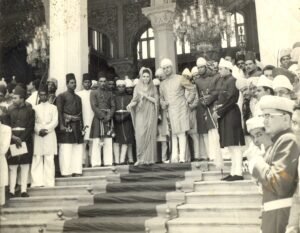The NITI Aayog was shaped on January 1, 2015. In Sanskrit, “NITI” signifies profound quality, conduct, direction, and so on. Yet, in the current setting, it implies strategy and the NITI means “National Institution for Transforming India”. The nation’s chief strategy making establishment is supposed to reinforce the monetary development of the country. It plans to build areas of strength for a that will assist with making a dynamic and solid country. This assists India with arising as a significant economy on the planet. The NITI Aayog’s creation has two centres called “Group India Hub” and “Information and Innovation Hub”.
- Group India: It prompts the support of Indian states with the focal government.
- The Knowledge and Innovation Hub: it assembles the foundation’s research organization capacities.
NITI Aayog is moreover making itself as a State-of-the-Art Resource Centre, with the fundamental assets, information, and abilities that will engage it to act with speed, advance examination and development, give urgent strategy vision to the public authority and oversee unexpected issues. The justification behind setting up the NITI Aayog is that individuals had assumptions for development and advancement in the organization through their cooperation. This necessary institutional changes in organization and dynamic methodology moves that could seed and cultivate significant scale change.
Objective of NITI Aayog
- To evolve a shared vision of national development priorities, sectors and strategies with the active involvement of States.
- To foster cooperative federalism through structured support initiatives and mechanisms with the States on a continuous basis, recognizing that strong States make a strong nation.
- To develop mechanisms to formulate credible plans at the village level and aggregate these progressively at higher levels of government.
- To ensure, on areas that are specifically referred to it, that the interests of national security are incorporated in economic strategy and policy.
- To pay special attention to the sections of our society that may be at risk of not benefiting adequately from economic progress.
- To design strategic and long-term policy and programme frameworks and initiatives, and monitor their progress and their efficacy. The lessons learned through monitoring and feedback will be used for making innovative improvements, including necessary mid-course corrections.
- To provide advice and encourage partnerships between key stakeholders and national and international like-minded think tanks, as well as educational and policy research institutions.
- To create a knowledge, innovation and entrepreneurial support system through a collaborative community of national and international experts, practitioners and other partners.
- To offer a platform for the resolution of inter-sectoral and inter departmental issues in order to accelerate the implementation of the development agenda.
- To maintain a state-of-the-art resource centre, be a repository of research on good governance and best practices in sustainable and equitable development as well as help their dissemination to stake-holders.
- To actively monitor and evaluate the implementation of programmes and initiatives, including the identification of the needed resources so as to strengthen the probability of success and scope of delivery.
- To focus on technology upgradation and capacity building for implementation of programmes and initiatives.
- To undertake other activities as may be necessary in order to further the execution of the national development agenda, and the objectives mentioned above.
Composition of NITI Aayog
- Prime Minister of India as the Chairperson
- Governing Council comprising the Chief Ministers of all the States and Lt. Governors of Union Territories
- Regional Councils will be formed to address specific issues and contingencies impacting more than one state or a region. These will be formed for a specified tenure. The Regional Councils will be convened by the Prime Minister and will comprise of the Chief Ministers of States and Lt. Governors of Union Territories in the region. These will be chaired by the Chairperson of the NITI Aayog or his nominee.
Experts, specialists and practitioners with relevant domain knowledge as special invitees nominated by the Prime Minister
The full-time organizational framework will comprise of, in addition to the Prime Minister as the Chairperson:
- Vice-Chairperson: To be appointed by the Prime Minister
- Members: Full-time
- Part-time members: Maximum of 2 from leading universities research organizations and other relevant institutions in an ex-officio capacity. Part time members will be on a rotational basis.
- Ex Officio members: Maximum of 4 members of the Union Council of Ministers to be nominated by the Prime Minister.
- Chief Executive Officer: To be appointed by the Prime Minister for a fixed tenure, in the rank of Secretary to the Government of India.
- Secretariat as deemed necessary.
Initiatives of NITI Aayog
- SDG India Index
- Composite Water Management Index
- Atal Innovation Mission
- SATH Project.
- Aspirational District Programme
- School Education Quality Index
- District Hospital Index
- Health Index
- Agriculture Marketing And Farmer Friendly reform Index
- India Innovation Index
- Women Transforming India Awards
- Good Governance Index
- Women Entrepreneurship Platform (WEP)
- Strategy for New India at 75
- ‘Methanol Economy’ programme
7 Pillars of Effective Governance
Features Of NITI Aayog
NITI Aayog is developing itself as a state-of-the-art resource centre with the necessary knowledge and skills that will enable it to act with speed, promote research and innovation, provide strategic policy vision for the government, and deal with contingent issues. It is supported by an attached office, Development Monitoring and Evaluation Organisation (DMEO), a flagship initiative, Atal Innovation Mission (AIM) and an autonomous body, National Institute of Labour Economics Research and Development (NILERD).
NITI Aayog’s entire gamut of activities can be divided into four main heads:
- Policy and Programme Framework
- Cooperative Federalism
- Monitoring and Evaluation
- Think Tank, and Knowledge and Innovation Hub
| Planning commissionPlanning Commission was an extra-sacred and non-legal body shaped by the goal of the Government of India in March 1950. It was a warning body to the Government of India on a variety of issues of financial turn of events. It was going by the Prime Minister as the ex-officio Chairman. It was disintegrated in 2014 and NITI Aayog supplanted this body.What is Planning commission?The Planning Commission of India was an administration establishment that, in addition to other things, figured out India’s Five-Year Plans. The arranging commission was entrusted with guaranteeing that everybody had the potential chance to work locally’s administration.The Planning Commission was straightforwardly capable to India’s Prime Minister. It was established on March 15, 1950, under the chairmanship of Prime Minister Jawaharlal Nehru. The Planning Commission was laid out by the Central/Union Government and was not laid out by the Constitution or rule.In March 1950, the Government of India passed a goal laying out the Planning Commission. The public authority’s primary objectives were to push a fast ascent in Indians’ expectations for everyday comforts through productive double-dealing of the nation’s assets, expanded yield, and giving opportunities to everybody to work in the help of society.The Planning Commission was entrusted with assessing the nation’s all’s assets, upgrading valuable assets, making arrangements for the most useful and adjusted utilization of assets, and deciding needs. The principal Chairman of the Planning Commission was Pandit Nehru.Elements of Planning CommissionMake an appraisal of the country’s capital, material, and HR, including specialized staff, and investigate ways of working on these assets for the country’s turn of events;Set up an arrangement for the most productive and adjusted utilization of the nation’s assets;Characterize the stages wherein the Plan will be executed, as well as the assets expected to finish each stage;Decide the causes that obstruct financial turn of events and the conditions that, considering the ongoing social and world of politics, ought to be laid out to guarantee the Plan’s effective execution.Decide the sort of apparatus expected for each step of the Plan to be finished effectively in all angles;Consistently survey the achievement made in executing the Plan at all stages and proposition any strategy or measure adjustments or changes that such an evaluation might view as fundamental;Make break or valuable suggestions to empower it to do the obligations shared with it, or in view of a survey of current financial circumstances, strategies, measures, and improvement plans, or an investigation of explicit issues that the Central or State Governments might allude to it.Planning Commission broke downRather than the Commission, which forced five-year designs and relegated assets to meet indicated monetary targets, advertisers of the new National Institution for Transforming India (NITI) contend it will work more like a research organization or discussion.The heads of India’s 29 states and seven association regions will be addressed at NITI Aayog. Be that as it may, the full-time group, which incorporates a delegate director, CEO, and specialists, will report straightforwardly to the 64-year-old Prime Minister, who will act as executive.It varies from the National Development Council’s arranging bonus, which used to answer to it.The significant contrast between the NITI Aayog and the Planning Commission’s ways to deal with arranging is that the previous will energize expanded state support, while the last option will adopt a hierarchical strategy with a one-size-fits-all arrangement.The Planning Commission’s obligation was to figure out expansive approach and act as a warning body.The NITI Aayog would be accountable for dispensing assets to states in view of their prerequisites.Strategy arranging, which was the obligation of the Planning Commission, had insignificant direct contribution from the states.The states were involved by implication through the National Development Council; this won’t repeat in the NITI Aayog. |
Difference Between Planning Commission & NITI Aayog
| Parameter | Planning Commission | NITI Aayog |
| Members | Full-time: 8 full-time membersPart-time: No provision as such for part-time members | Full-time: Fewer full-time membersPart-time: Depends on the need |
| Financial Clout | Could allocate funds to ministries and state governments | Is a think tank and advisory body |
| Role of the States | Role limited to the NDC and the annual interaction during the Plan meetings | State governments play a more significant role |
| Secretaries | Secretaries or member secretaries were appointments through the usual process | Secretaries will be called CEO and be appointed by the Prime Minister |
| Policy formation | Policies were formed by the Commission after which states were consulted about fund allocation | Consulting would be done while the policy is being formulated |
| Power to allocate funds | Had the power to allocate funds | No power to allocate funds |
| Policy imposition | Imposed policies on states | No power to impose policies |
Frequently Asked Questions
Q1. How NITI Aayog was framed?
Ans. NITI Aayog was framed through a goal of the Union Cabinet on 1 January 2015.
Q2. What are the 7 mainstays of NITI Aayog?
Ans. NITI Aayog depends on the 7 mainstays of successful administration – (1) Pro-People (2) Pro-Activity (3) Participation (4) Empowering (5) Inclusion of each of the (6) Equality (7) Transparency.
Q3. Why NITI Aayog supplanted Planning Commission UPSC?
Ans. NITI Aayog was set up on first January 2015 after the declaration made by Narendra Modi the Prime Minister of India, the rationale behind setting up NITI Aayog was to have a body that can give legitimate and basic techniques and headings in which the improvement cycle can happen.
Q4. Who is the head of NITI Aayog?
Ans. Shri Parameswaran Iyer




